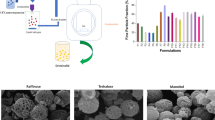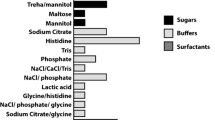Abstract
Pulmonary delivery of therapeutic peptides and proteins has many advantages including high relative bioavailability, rapid systemic absorption and onset of action and a non-invasive mode of administration which improves patient compliance. In this study, we investigated the effect of spray-drying (SD) and spray freeze-drying processes on the stability and aerosol performance of parathyroid hormone (PTH) (1-34) microparticles. In this study, the stabilisation effect of trehalose (a non-reducing sugar) and Brij 97 (a non-ionic surfactant) on spray-dried PTH particles was assessed using analytical techniques including circular dichroism (CD), fluorescence spectroscopy, modulated differential scanning calorimetry and an in vitro bioactivity assay. Physical characterisation also included electron microscopy, tap density measurement and laser light diffraction. The aerosol aerodynamic performance of the formulations was assessed using the Andersen cascade impactor. Based on these studies, a formulation for spray freeze-drying was selected and the effects of the two particle engineering techniques on the biophysical stability and aerosol performance of the resulting powders was determined. CD, fluorescence spectroscopy and bioactivity data suggest that trehalose when used alone as a stabilising excipient produces a superior stabilising effect than when used in combination with a non-ionic surfactant. This highlights the utility of CD and fluorescence spectroscopy studies for the prediction of protein bioactivity post-processing. Therefore, a method and formulation suitable for the preparation of PTH as a dry powder was developed based on spray-drying PTH with trehalose as a stabiliser with the bioactivity of SD PTH containing trehalose being equivalent to that of unprocessed PTH.





Similar content being viewed by others
References
Patton J. Pulmonary delivery of drugs for bone disorders. Adv Drug Deliv Rev. 2000;42(3):239–48.
Barrett-Connor E. The economic and human costs of osteoporotic fracture. Am J Med. 1995;98(2A):3S–8S.
Quattrocchi E, Kourlas H. Teriparatide: a review. Clin Ther. 2004;26(6):841–54.
Tashjian JRA, Chabner B. Commentary on clinical safety of recombinant human parathyroid hormone 1-34 in the treatment of osteoporosis in men and postmenopausal women. J Bone Miner Res. 2002;17:1151–61.
Shoyele S, Slowey A. Prospects of formulating proteins/peptides as aerosols for pulmonary drug delivery. Int J Pharm. 2006;314(1):1–8.
Akers M, Vasudevan V, Stickelmeyer M. Formulation development of protein dosage forms. In: Nail SL, Akers MJ, editors. Development and manufacture of protein pharmaceuticals. New York: Kluwer; 2002. p. 47.
Manning M, Patel K, Borchardt R. Stability of protein pharmaceuticals. Pharm Res. 1989;6(11):903–18.
Kobayashi S, Kondo S, Juni K. Pulmonary delivery of salmon calcitonin dry powders containing absorption enhancers in rats. Pharm Res. 1996;13(1):80–3.
Pfutzner A, Flacke F, Pohl R, Linkie D, Engelbach M, Woods R, et al. Pilot study with Technosphere/PTH (1-34)-a new approach for effective pulmonary delivery of parathyroid hormone (1-34). Horm Metab Res. 2003;35(5):319–23.
Codrons V, Vanderbist F, Verbeeck R, Arras M, Lison D, Préat V, et al. Systemic delivery of parathyroid hormone (1-34) using inhalation dry powders in rats. J Pharm Sci. 2003;92(5):938–50.
Shoyele S, Cawthorne S. Particle engineering techniques for inhaled biopharmaceuticals. Adv Drug Deliv Rev. 2006;58(9–10):1009–29.
Costantino H, Firouzabadian L, Wu C, Carrasquillo K, Griebenow K, Zale S, et al. Protein spray freeze drying. 2. Effect of formulation variables on particle size and stability. J Pharm Sci. 2002;91(2):388–95.
Engstrom J, Simpson D, Lai E, Williams III R, Johnston K. Morphology of protein particles produced by spray freezing of concentrated solutions. Eur J Pharm Biopharm. 2007;65(2):149–62.
Hillgren A, Aldén M. A comparison between the protection of LDH during freeze-thawing by PEG 6000 and Brij 35 at low concentrations. Int J Pharm. 2002;244(1–2):137–49.
Jovanovic N, Bouchard A, Hofland G, Witkamp G, Crommelin D, Jiskoot W. Distinct effects of sucrose and trehalose on protein stability during supercritical fluid drying and freeze-drying. Eur J Pharm Sci. 2006;27(4):336–45.
Ameri M, Maa Y. Spray drying of biopharmaceuticals: stability and process considerations. Drying Technol. 2006;24(6):763–8.
Jeon J, Puleo D. Formulations for intermittent release of parathyroid hormone (1-34) and local enhancement of osteoblast activities. Pharm Dev Technol. 2008;13(6):505–12.
Johnson K. Preparation of peptide and protein powders for inhalation. Adv Drug Deliv Rev. 1997;26(1):3–15.
Maa Y, Nguyen P, Sweeney T, Shire S, Hsu C. Protein inhalation powders: spray drying vs spray freeze drying. Pharm Res. 1999;16(2):249–54.
Yu Z, Johnston K, Williams III R. Spray freezing into liquid versus spray-freeze drying: Influence of atomization on protein aggregation and biological activity. Eur J Pharm Sci. 2006;27(1):9–18.
Edwards D, Hanes J, Caponetti G, Hrkach J, Ben-Jebria A, Eskew M, et al. Large porous particles for pulmonary drug delivery. Science. 1997;276(5320):1868.
Manavalan P, Johnson W. Protein secondary structure from circular dichroism spectra. J Biosci. 1985;8(1):141–9.
Kanaori K, Takai M, Nosaka A. Comparative study of chicken and human parathyroid hormone-(1-34)-peptides in solution with SDS. Eur J Biochem. 2004;249(3):878–85.
Demeule B, Lawrence M, Drake A, Gurny R, Arvinte T. Characterization of protein aggregation: the case of a therapeutic immunoglobulin. Biochimica et Biophysica Acta (BBA)-Proteins & Proteomics. 2007;1774(1):146–53.
Capelle M, Gurny R, Arvinte T. High throughput screening of protein formulation stability: practical considerations. Eur J Pharm Biopharm. 2007;65(2):131–48.
Costantino H, Firouzabadian L, Hogeland K, Wu C, Beganski C, Carrasquillo K, et al. Protein spray-freeze drying. Effect of atomization conditions on particle size and stability. Pharm res. 2000;17(11):1374–82.
Lechuga-Ballesteros D. S, L. M., Vehring, R., Kuo M-C (eds). Use of a novel excipient to enable the preparation of stable and dispersible dry powder aerosol formulation by spray drying. In: 30th Annual Meeting and Symposium of the Controlled Release Society, Glasgow, Scotland; 2003
Chan H. Dry powder aerosol drug delivery—opportunities for colloid and surface scientists. Colloids Surf A. 2006;284:50–5.
Acknowledgements
This research was supported by Science Foundation Ireland under grants SFI RFPENG0020 & SFI07/SRC/B1154.
Author information
Authors and Affiliations
Corresponding author
Rights and permissions
About this article
Cite this article
Shoyele, S.A., Sivadas, N. & Cryan, SA. The Effects of Excipients and Particle Engineering on the Biophysical Stability and Aerosol Performance of Parathyroid Hormone (1-34) Prepared as a Dry Powder for Inhalation. AAPS PharmSciTech 12, 304–311 (2011). https://doi.org/10.1208/s12249-011-9585-2
Received:
Accepted:
Published:
Issue Date:
DOI: https://doi.org/10.1208/s12249-011-9585-2




